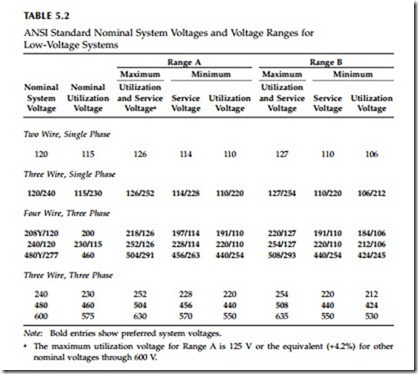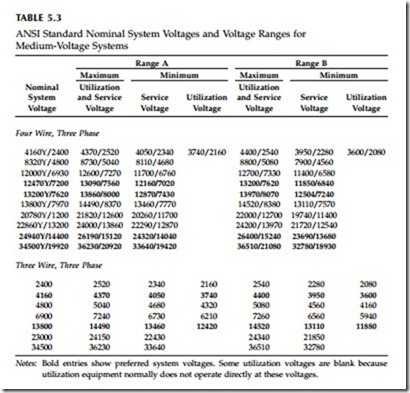One of a utility’s core responsibilities is to deliver voltage to customers within a suitable range, so utilities must regulate the voltage. On distribution circuits, voltage drops due to current flowing through the line impedances. Primary and secondary voltage drop can be allocated as necessary along the circuit to provide end users with suitable voltage. Voltage regulators — in the substation or on feeders — can adjust primary voltage. This chapter discusses voltage regulators and regulation standards and techniques.
Voltage Standards
Most regulatory bodies and most utilities in America follow the ANSI voltage standards (ANSI C84.1-1995). This standard specifies acceptable operational ranges at two locations on electric power systems:
• Service voltage — The service voltage is the point where the electrical systems of the supplier and the user are interconnected. This is normally at the meter. Maintaining acceptable voltage at the service entrance is the utility’s responsibility.
• Utilization voltage — The voltage at the line terminals of utilization equipment. This voltage is the facility’s responsibility. Equipment manufacturers should design equipment which operates satisfacto- rily within the given limits.
The standard allows for some voltage drop within a facility, so service voltage requirements are tighter than utilization requirements.
The standard also defines two ranges of voltage:
• Range A — Most service voltages are within these limits, and utilities should design electric systems to provide service voltages within
these limits. As the standard says, voltage excursions “should be infrequent.”
• Range B — These requirements are more relaxed than Range A limits.
According to the standard: “Although such conditions are a part of practical operations, they shall be limited in extent, frequency, and duration. When they occur, corrective measures shall be undertaken within a reasonable time to improve voltages to meet Range A requirements.” Utilization equipment should give acceptable performance when operating within the Range B utilization limits, “insofar as practical” according to the standard.
These limits only apply to sustained voltage levels and not to momentary excursions, sags, switching surges, or short-duration interruptions.
Table 5.1 shows the most important limits, the limits on low-voltage systems. The table is given on a 120-V base; it applies at 120 V but also to any low-voltage system up to and including 600 V. The main target for utilities is the Range A service voltage, 114 to 126 V.
ANSI C84.1 defines three voltage classes: low voltage (1 kV or less), medium voltage (greater than 1 kV and less than 100 kV), and high voltage (greater than or equal to 100 kV). Within these classes, ANSI provides standard nominal system voltages along with the voltage ranges. A more detailed summary of the ANSI voltages is shown in Table 5.2 and Table 5.3.
For low-voltage classes, two nominal voltages are given — one for the electric system and a second, somewhat lower, nominal for the utilization equipment (for low-voltage motors and controls; other utilization equipment may have different nominal voltages). In addition, the standard gives common nameplate voltage ratings of equipment as well as information on what nominal system voltages the equipment is applicable to. As the standard points out, there are many inconsistencies between equipment voltage rat- ings and system nominal voltages.
For medium-voltage systems, ANSI C84.1 gives tighter limits for Ranges A and B. Range A is –2.5 to +5%, and Range B is –5 to +5.8%. However, most utilities do not follow these as limits for their primary distribution systems (utilities use the ANSI service voltage guidelines and set their primary volt- age limits to meet the service voltage guidelines based on their practices). The three-wire voltages of 4,160, 6,900, and 13,800 V are mainly suited for industrial customers with large motors. Industrial facilities use motors on these systems with ratings of 4,000, 6,600, and 13,200 V, respectively.
Improper voltage regulation can cause many problems for end users. Sus-ained overvoltages or undervoltages can cause the following end-use impacts:
• Improper or less-efficient equipment operation — For example, lights may give incorrect illumination or a machine may run fast or slow.
• Tripping of sensitive loads — For example, an uninterruptible power supply (UPS) may revert to battery storage during high or low voltage. This may drain the UPS batteries and cause an outage to critical equipment.
In addition, undervoltages can cause
• Overheating of induction motors — For lower voltage, an induction motor draws higher current. Operating at 90% of nominal, the full- load current is 10 to 50% higher, and the temperature rises by 10 to 15%. With less voltage, the motor has reduced motor starting torque.
Also, overvoltages can cause
• Equipment damage or failure — Equipment can suffer insulation dam- age. Incandescent light bulbs wear out much faster at higher volt- ages.
• Higher no-load losses in transformers — Magnetizing currents are higher at higher voltages.



